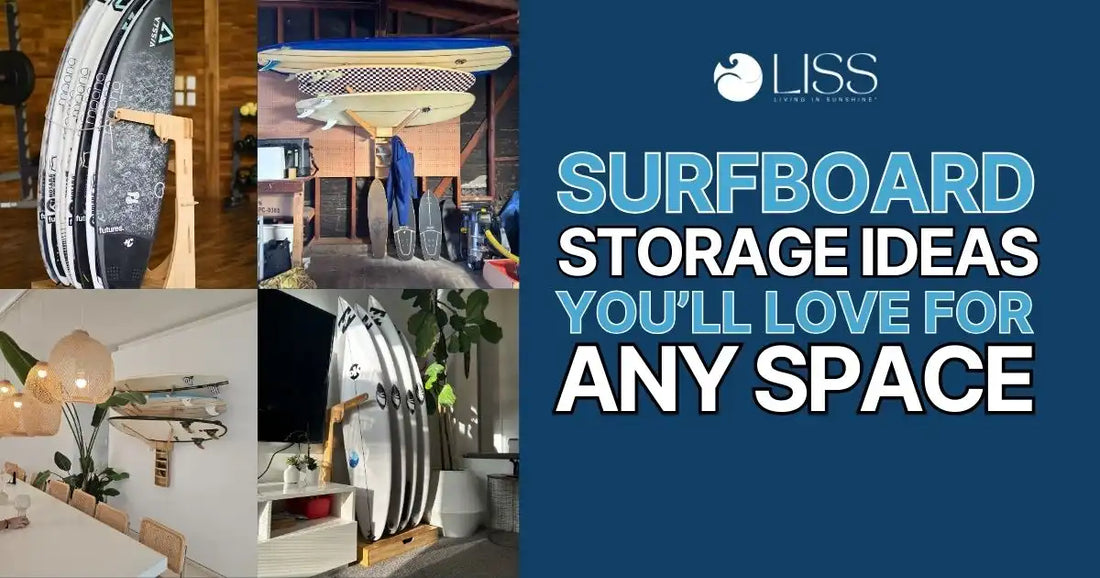
Surfboard Storage Ideas You’ll Love for Any Space
Share
You can mount boards on wall racks to save floor space, use ceiling hoists in garages, or add freestanding racks for easy access. For smaller spaces, vertical stands or decorative wall mounts double as storage and display. These solutions keep your surfboards safe, organized, and ready for your next session.
Surfboards piling up in hallways, garages, or living areas isn’t only frustrating, it shortens the life of your boards. The Surf Industry Manufacturers Association (SIMA), a leading trade association for surf industry brands and manufacturers, reports that surfboards kept in controlled environments last 30% longer than those exposed to heat, moisture, or harsh conditions. Proper storage isn’t just about keeping your space organized, it’s about protecting your investment.
So, what are the best surfboard storage ideas that keep your boards safe while freeing up valuable space?
Why Proper Storage Matters?
Proper surfboard storage protects your boards from damage and extends their usability. When surfboards are left leaning in hallways, stacked in garages, or exposed to heat and moisture, they’re more likely to suffer from dings, warping, or delamination. Creating a dedicated storage solution keeps them safe, maintains performance, and ensures they’re always ready for use.
Good storage also improves safety and saves space. Surfboards that aren’t secured can tip over, cause injuries, or damage other belongings. Options like wall racks, ceiling hoists, and freestanding stands keep boards organized, prevent accidents, and free up valuable space in living areas or garages.
How To Store Surfboards: 8 Surfboard Storage Ideas
Here are some of the surfboard storage ideas you should try:
1. Vertical & Wall-Mounted Racks

Vertical surfboard racks and wall-mounted systems are some of the most efficient ways to store surfboards. They save valuable floor space, keep boards upright, and reduce the risk of tipping. Modular wall racks can be adjusted to fit multiple boards, while heavy-duty versions are ideal for long-term collections, making them one of the best ways to store surfboards.
For a stylish and durable option, check out The Solo Rack for single board storage or The Sun Rack if you want a multi-board setup. Both are built to keep your surfboards secure while blending well with home, apartment, or garage spaces.
Best for: Homes, apartments, and garages with limited floor space.
Pro Tip: Add padding or rubber grips to surfboard racks to prevent scratches.
2. Ceiling & Overhead Storage
When floor and wall space are limited, ceiling racks and pulley systems are game changers. By hoisting boards overhead, you free up space below while keeping surfboards safe from accidental knocks. This method of hanging surfboard from ceiling is especially useful for garages or storage units.
Best for: Garages, storage units, and homes with tall ceilings.
Pro Tip: Choose pulley systems with secure locking to prevent slips.
3. Freestanding & DIY Solutions
Freestanding racks and DIY surfboard stands are flexible options for renters or anyone who doesn’t want to drill into walls. These solutions can be customized to fit your number of boards, room size, and budget. DIY builds using wood or PVC pipes are cost-effective and add a personal touch.
If you prefer something ready-made and stylish, The Spirit Rack offers a clean, durable design that looks great in any space while keeping your boards secure and accessible.
Best for: Renters, small homes, and budget-conscious surfers.
Pro Tip: Keep freestanding racks away from high-traffic areas to avoid accidents.
4. Portable Unit & Climate-Controlled Storage
For long-term or seasonal storing surfboards, especially if space at home is tight, climate-controlled storage units are a safe option. Controlled environments protect surfboards from heat, humidity, and moisture that can damage foam and fiberglass. Portable racks or cases can also make transporting boards easier.
Best for: Long-term storage, off-season protection, and humid climates.
Pro Tip: Store boards on racks inside units, not directly on the floor.
5. Board Bags, Desiccants, and Cleaning Practices

Good storage isn’t complete without protection. Surfboard bags shield against dings, UV rays, and dust, while desiccant packs reduce moisture build-up in humid areas. Regular cleaning like rinsing saltwater, removing wax before storage, and checking for cracks also extends board life.
Best for: Everyday surfers and seasonal storage.
Pro Tip: Always store boards dry to avoid mold and mildew.
6. Styling & Accessibility in Small Spaces
Surfboard storage can double as décor. Wall slings, decorative wooden racks, and shelving systems keep boards accessible while adding coastal style to your space. Pinterest-worthy setups turn surfboards into functional art, perfect for apartments or small homes.
Best for: Small apartments, shared spaces, or style-conscious surfers.
Pro Tip: Use matching finishes and materials to blend with interior design.
7. Outdoor & Climate-Aware Storage
Storing boards outdoors requires extra care. Direct sun, humidity, and weather can quickly degrade materials. If outdoor storage is unavoidable, use weatherproof racks, UV-protective covers, or shaded areas to minimize exposure.
Best for: Homes with limited indoor space.
Pro Tip: Always cover boards with UV-resistant bags or tarps.
8. Seasonal & Off-Season Strategies
When the surf season ends, boards need extra prep for long-term storage. This means cleaning thoroughly, removing wax, and repairing dings before storage. A kit like The Wax Box makes the waxing process easier and more consistent, so your board is always ready when it’s time to swap in for the season. Rotating boards in and out seasonally keeps them in good shape and ready for the next wave.
Best for: Surfers with multiple boards or seasonal surf habits.
Pro Tip: Store off-season boards vertically in padded racks for added safety.
Quick Tips for Long-Term Surfboard Storage

For quick tips on making your surfboard storage last longer, here are some you can try:
Always Rinse Off Salt Before Storing
After a surf session, saltwater left on your board can gradually eat away at the surface and corrode metal parts like fins or screws. A quick rinse with fresh water and a gentle wipe down prevents damage and keeps your board looking clean. For an even easier solution, try The Clean Fin, a simple tool designed to make rinsing and maintaining your surfboard hassle-free.
Use Board Bags For Extra Protection
A padded board bag shields your surfboard from scratches, dings, and accidental knocks in storage. It also helps protect against UV exposure and dust, making it essential if you store your board in shared spaces like garages or sheds.
Store Away From Heat Sources
Direct sunlight, heaters, or hot car interiors can cause delamination and weaken the board’s structure. Keep your surfboard in a cool, shaded spot where temperatures remain stable.
Regularly Rotate Board Position To Avoid Pressure Spots
Leaving a surfboard in the same position for months can create dents or warping, especially if it’s leaning against a hard surface. Rotate it between vertical, horizontal, or rack storage to evenly distribute pressure and maintain the board’s shape.
Keep Your Boards Safe and Ready
Storing your surfboards isn’t just about finding a spot to keep them out of the way — it’s about protecting the boards that connect you to the ocean. A well-thought-out storage system saves space, prevents costly repairs, and extends the life of your quiver, but it also builds consistency into your surf routine. When your boards are organised, protected, and always within reach, you spend less time worrying about damage and more time chasing waves.
Think of storage as part of your surf investment: the better care you give your boards at home, the better they’ll perform in the water when the swell rolls in. At Living in Sunshine, we’re passionate about helping surfers create spaces that reflect their lifestyle. That’s why our Freestanding & Wall-Mounted Board Racks Collection is designed to keep your boards safe, accessible, and beautifully displayed, all while blending seamlessly into your home.
FAQs
What is the most efficient way to store surfboards?
The most efficient and best way to store surfboards is to use a padded rack and store your surfboard either horizontally with even support or vertically on its tail. Both methods prevent warping and help maintain the board’s shape.
Can you store a surfboard outside?
Yes, you can store a surfboard outside, but it needs protection from sun and weather. Keep it in a shaded area or use a board bag, UV-resistant cover, or thick towel to block sunlight. When at the beach, limit exposure by using a board sock or resting it deck-side down. Reducing direct sun contact helps prevent yellowing, delamination, and keeps the fibreglass strong for longer.
Can you store surfboards upright?
Yes, you can store surfboards upright as long as they are secured properly to avoid tipping or pressure dings. The safest option is to place them in a dedicated board rack that holds the board vertically, but leaning them in a padded corner can also work for short-term storage. For saving floor space, ceiling-mounted garage racks are another excellent solution, keeping boards overhead, protected, and leaving room for cars and other items.
Is it bad to leave a surfboard in the rain?
Yes, leaving a surfboard in the rain is damaging. Water, sun, and even morning moisture can seep into cracks or weaken the board’s materials, leading to warping, delamination, and reduced durability. For long-term protection, surfboards should always be stored indoors or in a dry, sheltered area.

